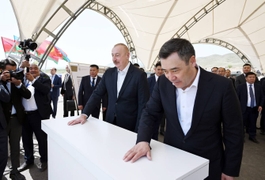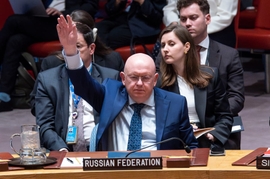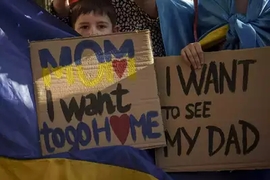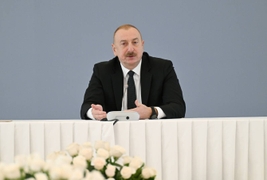The Western Azerbaijan Community (WAC), an umbrella organization advocating for the protection of the rights of displaced Azerbaijanis, has called on Armenian authorities to start negotiations for the return of Azerbaijanis to their homes in the territory of modern-day Armenia.
According to WAC, the fact that Azerbaijanis expelled from the territory of nowadays Armenia still cannot return to their homes, the mono-ethnic statehood, ethnic cleansing, and systematic racial discrimination in this country [Armenia] represent major obstacles to the establishment of lasting peace in the region.
“The Western Azerbaijan Community calls on the Government of Armenia to immediately start negotiations with the Community within the framework of a relevant international process so that the Azerbaijanis it expelled from Armenia can return to their homeland peacefully, in safety, and dignity,” reads WAC’s statement published on Monday.
The request came on the heels of the celebration of the separatist movement’s anniversary by Armenians living in the Karabakh (Garabagh) region of Azerbaijan.
On Monday, Armenian residents in the Karabakh region of Azerbaijan gathered to mark the 35th anniversary of the separatist movement that spawned a mass anti-Azerbaijan campaign in Armenia in 1988 and further morphed into a bloody war from 1991-1994.
On February 20, 1988, the members of the Armenian separatist movement in the mountainous part of the Karabakh region of Azerbaijan, illegally adopted a so-called "decision" to leave Azerbaijan and join Soviet Armenia.
Following the Soviet Union’s dissolution in 1991, Armenia's illegal claims for the Karabakh region switched to a full-scale military campaign against Azerbaijan. The bloody war until a ceasefire in 1994 saw Armenia occupying 20 percent of Azerbaijan’s internationally recognized territories. Over 30,000 Azerbaijanis were killed, and one million were expelled from those lands in a brutal state-sponsored ethnic cleansing policy by Armenia.
In a statement on Monday, WAC said that long before the separatist demonstrations, Armenia had already made territorial claims against Azerbaijan and started a total ethnic cleansing by means of violence against the Azerbaijanis living in Soviet Armenia.
“These processes initiated by Armenia served the creation of a mono-ethnic space and territorial expansion which are contrary to human rights and international law. Through this racist and aggressive approach, Armenia expelled Azerbaijanis from its territory, occupied the internationally recognized territories of Azerbaijan and expelled all Azerbaijanis from there,” the statement reads.
In January, WAC adopted a framework entitled the Concept on Ensuring Peaceful, Safe and Dignified Return of Azerbaijanis Expelled from nowadays Armenia,” or the “Concept of Return”, which outlines objectives, principles, preparatory, and implementation measures to be taken by the Community to facilitate the return of Azerbaijanis.
The concept is based on international law, relevant domestic law, and historical facts, and aims to establish justice and peace.
As part of the concept, WAC stated that all Azerbaijanis expelled from modern-day Armenia and their descendants have the right to return to their homeland safely. It also states that returnees’ individual and collective rights must be guaranteed.
On January 31, 2023, an appeal issued by the WAC to the international community was circulated as a document of the UN General Assembly, the Security Council, and the Economic and Social Council. The document conveyed the truth about the fate of Azerbaijanis expelled from modern-day Armenia to representatives of 190 countries.
Western Azerbaijan
The historical lands of Azerbaijan on the country’s western edge were originally settled by ethnic Azerbaijanis before they were included in destructive plans developed by the Russian imperial and Soviet authorities. The city of Iravan (modern-day Yerevan) and the Zangazur region was one of the cradles of the Azerbaijani population and culture before their forcible separation from the Azerbaijan Democratic Republic (ADR) in 1918 and 1920, respectively.
Iravan had been initially settled by ethnic Azerbaijanis after its establishment by their ancestors. Although Iravan was handed over “willingly” to the newly established Armenian state by the ADR government, historical sources claim it to be organized and implemented forcibly under the pressure of foreign forces.
Zangazur is a historically Azerbaijani region that forms the southern part of modern-day Armenia and a portion of the territory of Azerbaijan.
The Zangazur region, inhabited by the Turkic tribes, was a part of the Seljuk empire during its 150-year-long rule in the 11th and 12th centuries, which further expanded the Turkic-Islamic influence within the region. Starting from the 13th century, Zangazur was invaded by Mongol-Tatar tribes and the Timurid Empire. From the 15th century to the 18th century, the region was a part of the medieval Azerbaijani states of Garagoyunlu, Aghgoyunlu, and Safavids.
Demographic changes in the city of Iravan and the Zangazur region took place during the reign of Tsarist Russia and the Soviet Union. A massive relocation of Armenians by the Russian Empire to Iravan, Zangazur, and other territories of Azerbaijan started in the wake of the Russian Empire’s victory over Iran in two wars in the 1804-1812 and 1826-1828 war.
A special commission was established to deal with the deployment of Armenians from Ottoman and Iranian territories to the South Caucasus. Following the relocation, the number of Armenians in the Karabakh region of Azerbaijan reached 18,000 between 1828 and 1829 and increased to 34,606 by 1843. The next wave of deployment of Armenians into the South Caucasus by Russia lasted from 1904 to 1915, when over 260,000 ethnic Armenians were placed in the territories of Azerbaijan. Despite protests, around 130,000 Armenians were relocated to the Azerbaijani provinces of Iravan and Yelizavetpol (the name of Azerbaijan’s Ganja city during Tsarist Russia's period).
As a result of the massacres committed by Armenian armed groups in 1905-1907 and 1914-1921 in Zangazur, about half a million indigenous Azerbaijanis and other Muslim locals were killed. In those years, 115 Muslim villages in Zangazur have been wiped off the face of the earth.
Iravan was ceded to the newly-established Armenian republic on May 29, 1918. Shortly after the Bolshevik forces subjugated the Azerbaijan Democratic Republic on April 28, 1920, a significant part of the Zangazur region was also ceded to the newly-established Armenian Soviet Socialist Republic on November 30, 1920. The annexation of the territories by Armenia took place under the aegis of the Soviet empire, which forced the Azerbaijani authorities to make territorial concessions to Armenians. As a result, Nakhchivan became an exclave separated from the Azerbaijani mainland.
The annexation of Iravan took its toll on its indigenous Azerbaijani population and the cultural heritage of Azerbaijanis. According to 1916 data, there were over 373,000 Azerbaijanis living in Iravan, however, only 12,000 Azerbaijanis were registered in census files in 1922.
In 1933, the territory of the Armenian SSR was divided into districts and the name Zangazur was changed to new district names such as Gafan, Gorus, Garakilsa (Sisian), and Mehri.
The final round of the “Armenianization” of Western Azerbaijan took place in 1988 when over 300,000 ethnic Azerbaijanis living in the historical Western Azerbaijan region, or modern-day Armenia, were expelled forcibly from their ancestral lands. The anti-Azerbaijan sentiments in Armenia were then on the rise accompanied by pogroms and persecution of ethnic Azerbaijanis. The motives for the ethnic conflict were Armenia’s illegal claims for the territories of Azerbaijan, namely the Karabakh region. The deportation of Azerbaijanis later led to the launch of a full-scale military attack on Azerbaijan by Armenia, leading to the first Karabakh war in 1991-1994 and the occupation of the internationally recognized Azerbaijani lands.


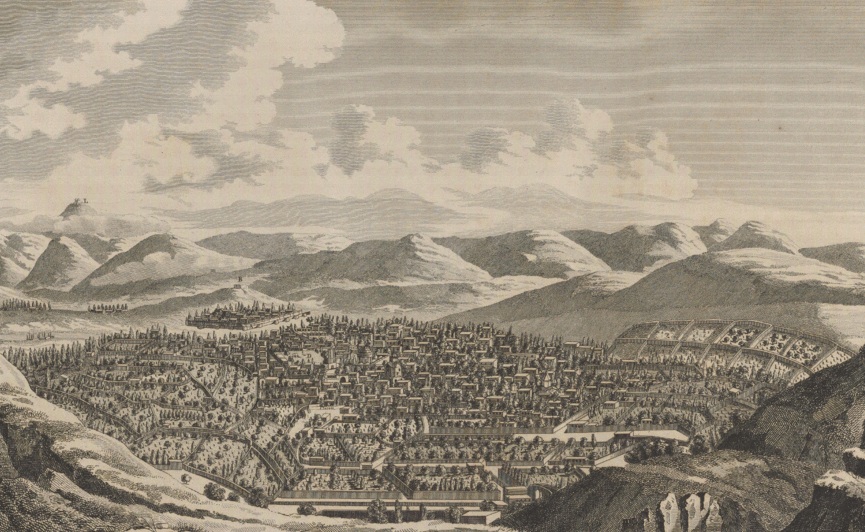




 President Ilham Aliyev shed light on the evolving contours of the peace process with Armenia during an international conference in Baku this week. ...
President Ilham Aliyev shed light on the evolving contours of the peace process with Armenia during an international conference in Baku this week. ...
 Azerbaijan and Armenia started the process of demarcation of their border on Tuesday, with the installation of the first border markers based on ge...
Azerbaijan and Armenia started the process of demarcation of their border on Tuesday, with the installation of the first border markers based on ge...
 Iranian President Ebrahim Raisi expressed Tehran’s readiness to participate in significant development projects in Sri Lanka during the inauguratio...
Iranian President Ebrahim Raisi expressed Tehran’s readiness to participate in significant development projects in Sri Lanka during the inauguratio...
 As the conflict between Ukraine and Russia escalates, the strategic importance of Kharkiv, Ukraine's second-largest city, has come sharply into focus.
As the conflict between Ukraine and Russia escalates, the strategic importance of Kharkiv, Ukraine's second-largest city, has come sharply into focus.
 Iran and Pakistan have signed eight cooperation documents in various fields, and agreed to strengthen ties to fight terrorism in the region.
Iran and Pakistan have signed eight cooperation documents in various fields, and agreed to strengthen ties to fight terrorism in the region.
